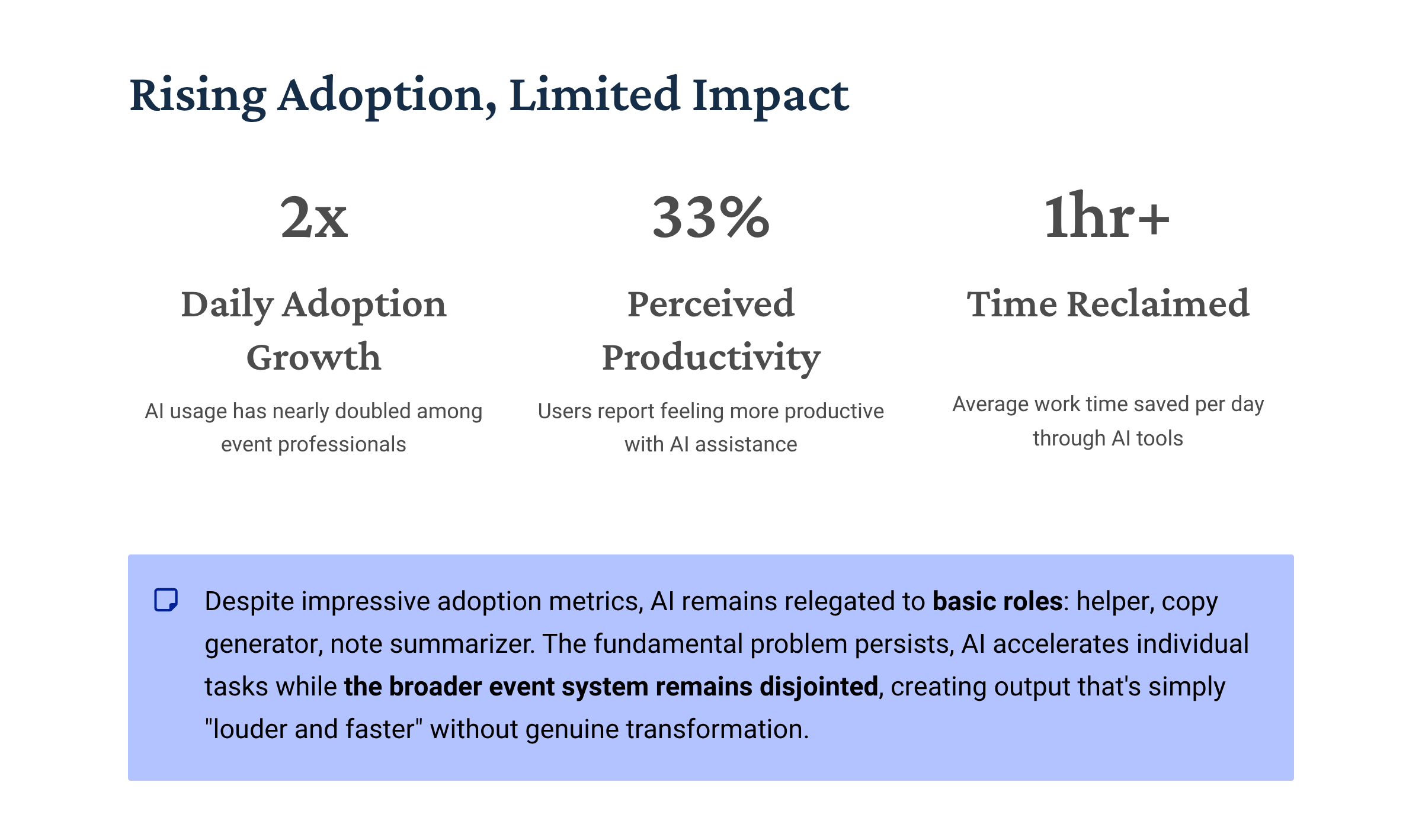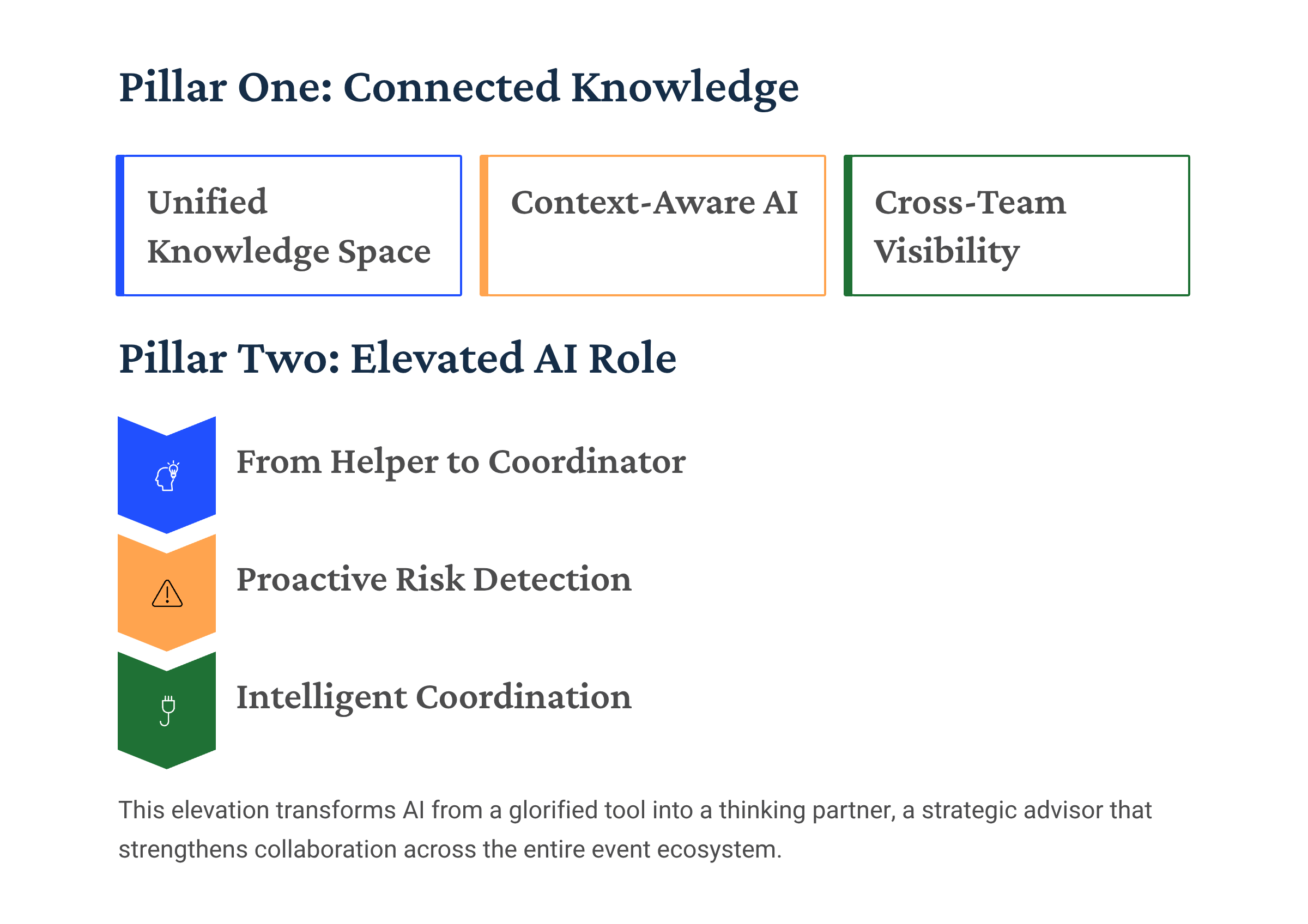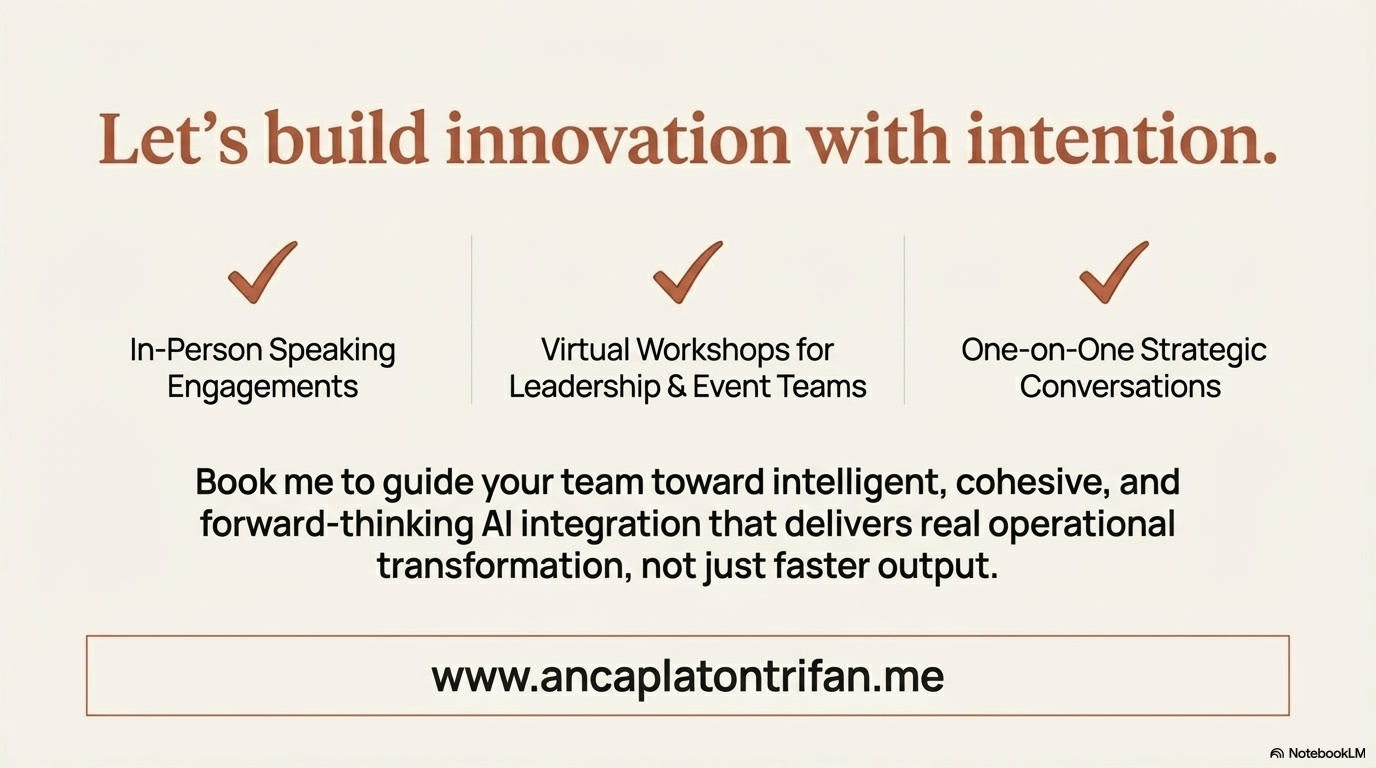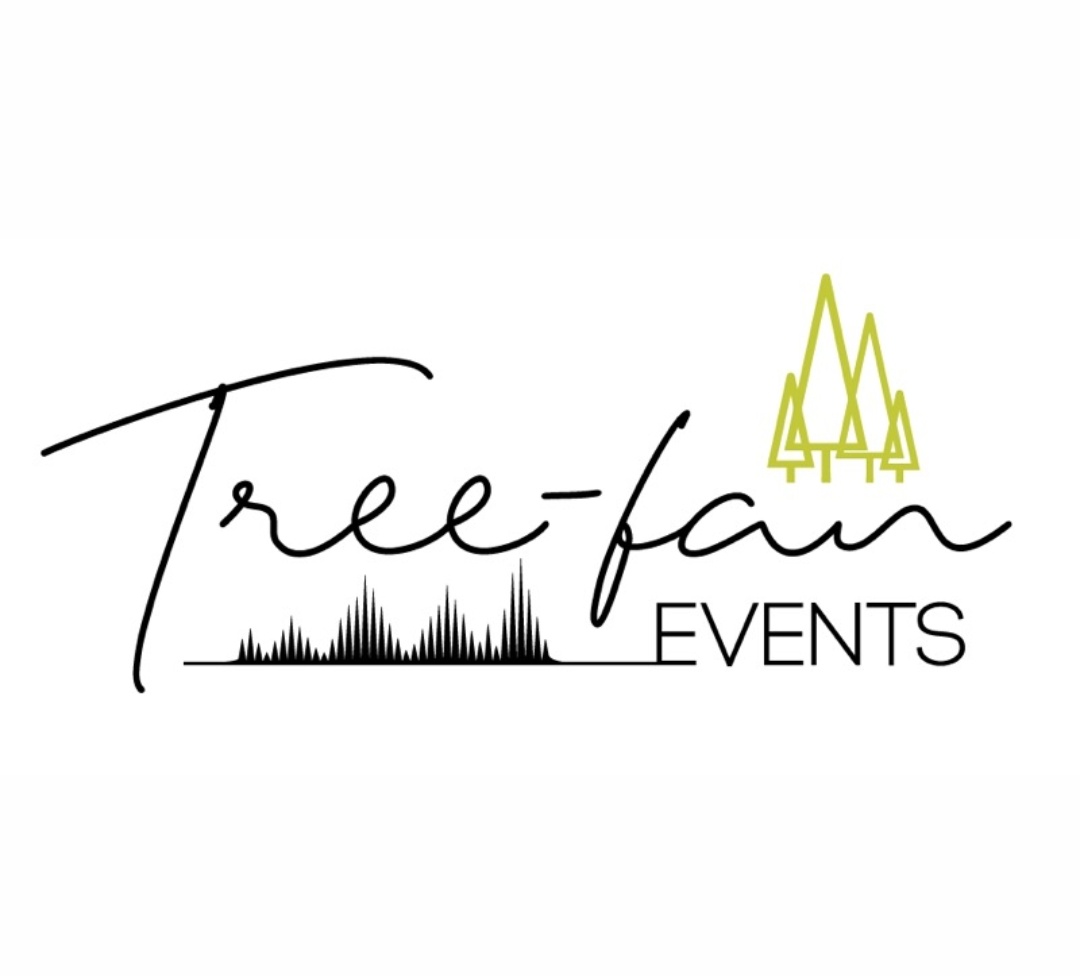AI Is Making Event Teams Faster. But Faster Is Not the Point.
Here’s what nobody wants to hear: AI is everywhere in your workflow, your team feels more productive than ever, and yet your organization is probably not seeing any real transformation. Not in efficiency. Not in innovation. Not in the quality of work that actually matters. The real question isn’t whether to use AI, it’s how to build AI collaboration for events that transforms your entire workflow, not just individual tasks.
The Atlassian AI Collaboration Index 2025 surveyed 12,000 knowledge workers and 180 Fortune 1000 executives, and the findings land somewhere between validating and unsettling. We are using more AI. We are moving faster. And we are still drowning in the same chaos we had before, just with better tools to accelerate it.

For event professionals, this hits differently. Because in our world, “faster” without “better” does not just mean wasted time. It means visible failures. Live mistakes. Experiences that fall flat because the infrastructure behind them was never designed for the speed we are now moving at.
The Numbers That Matter
- 96% of organizations report AI has not delivered meaningful transformation at the organizational level
- 33% average productivity increase reported by individual workers
- 1.3 hours saved per day per worker on average
- 4% of organizations seeing actual transformational benefits from AI
- $98 billion potential annual loss for Fortune 500 companies focusing on productivity over innovation
- 79% of workers say they would use AI more if it could access the right data
- 37% of executives say AI has wasted their teams’ time or led them in the wrong direction
- 76% of executives say increased employee productivity is their #1 indicator of AI ROI (but this focus correlates with 16% less likelihood of driving innovation)
- Only 1 in 3 knowledge workers fully trust AI outputs
- 42% admit to trusting AI outputs without checking accuracy due to time pressure
Events Are Ecosystems, Not Assembly Lines
Events are not linear operations. They are ecosystems. Pre-event strategy, content development, AV execution, speaker management, sponsor coordination, attendee engagement, post-event analytics—all moving in parallel, often with different tools, different documentation habits, and different mental models. AI speeding up a single person inside that system is helpful. But helpful does not equal transformative.
The report identifies a small group of organizations, about four percent, that are seeing real impact. Not cosmetic productivity gains. Actual structural change. The difference is not the tools themselves. It is how those tools are integrated into the collective intelligence of the team.
What the 4% Do Differently
 They prioritize connected knowledge. They move away from scattered documents, isolated folders, and siloed email chains. Instead, they create shared systems where institutional memory is preserved and accessible. In an event context, this means speaker preferences, AV specs, sponsor commitments, historical feedback, and operational lessons living in a connected environment. When AI sits on top of that, it stops guessing and starts supporting with contextual awareness.
They prioritize connected knowledge. They move away from scattered documents, isolated folders, and siloed email chains. Instead, they create shared systems where institutional memory is preserved and accessible. In an event context, this means speaker preferences, AV specs, sponsor commitments, historical feedback, and operational lessons living in a connected environment. When AI sits on top of that, it stops guessing and starts supporting with contextual awareness.
They enable AI-powered coordination. Not just content generation, but orchestration. AI becomes part of the workflow. It flags mismatches, identifies dependencies, surfaces risks, and supports real-time decision-making.
Imagine AI noticing that a keynote presentation includes embedded video exceeding the codec capabilities of the venue system and alerting the AV lead before doors open. Imagine it recognizing conflicting schedules between a sponsor activation and a keynote and suggesting a resolution. That is coordination, not convenience.
They shift the mindset from tool to collaborator. The highest performing teams treat AI more like a panel of expert advisors rather than a glorified typewriter. The language changes. The intention changes. The relationship changes. That subtle psychological framing leads to higher quality outputs and more thoughtful integration.
The Productivity Trap: Speed Without Redesign
Another critical insight from the report is the productivity trap. When organizations focus only on making people faster, they often miss the deeper opportunity to rethink how work is structured. In some cases, eliminating simple tasks leaves behind only high-cognitive-load work, increasing burnout. Speed without redesign becomes a treadmill that moves faster but still goes nowhere.
For event teams, this is a familiar pattern:
- Faster slide reviews
- Faster email follow-ups
- Faster social copy
But if workflows remain reactive, if knowledge remains fragmented, if roles remain poorly defined, the event itself does not get better. It just arrives quicker.
The report also highlights a shift in necessary skills. The future is not purely technical. The most valuable capabilities include:
- Creativity (55% say this is critical for the future)
- Technical proficiency (49%)
- Critical thinking and reasoning (46%)
- Adaptability/flexibility (46%)
In live event environments where mistakes are visible and real-time, human judgment becomes even more essential. AI must be supported by human discernment, clarity of roles, and defined accountability.
The Real Question: How Do We Redesign for Synergy?
This leads to a more meaningful question for event leaders. Not how do we use AI more. But how do we redesign our event ecosystem so AI strengthens collaboration instead of simply accelerating chaos.
What does this look like in practice?
 Audit how knowledge flows across teams. Design workflows that allow AI to support handoffs between departments. Define the role AI plays in each stage of the event lifecycle. Ask what you do with the time gained. Do you reinvest it into better attendee experiences, smarter programming, richer content repurposing, or deeper audience understanding.
Audit how knowledge flows across teams. Design workflows that allow AI to support handoffs between departments. Define the role AI plays in each stage of the event lifecycle. Ask what you do with the time gained. Do you reinvest it into better attendee experiences, smarter programming, richer content repurposing, or deeper audience understanding.
“At this moment, AI doesn’t help collaboration between teams. That’s a big pain point. How can it actually make teams work better together?”
— Head of Digital, Fortune 1000 Financial Services Company
The report quantifies the cost of getting this wrong. Focusing on personal productivity over innovation could cost the Fortune 500 $98 billion annually in lost returns on their AI investments.
From Speed to Synergy
The real frontier is not speed. It is synergy. AI has the potential to become the quiet architect behind a more coherent, responsive, and intelligent event operation. One that learns from itself. One that evolves. One that transforms every show into a feedback loop for the next.
The organizations bridging the gap between individual productivity and company-wide impact are doing three things differently:
1. Building Connected, Company-Wide Knowledge Bases
What this looks like:
- Document in digital whiteboards and shared pages
- Include AI notetakers in meetings that automatically create transcripts and assign action items
- Mark work status as “draft,” “in progress,” or “verified” so AI knows what information should and should not be shared
- Default to public channels instead of direct messages so context is accessible
- Use quick videos stored in connected platforms that export precise transcripts
The stat: 79% of workers say they would use AI more if it could access the right data and information.
2. Setting Up Systems for AI-Powered Coordination
What this looks like:
- Set 3-5 clear goals per team and document them in a centralized platform
- Map each goal to department and organization-wide milestones
- Review goals quarterly to ensure they reflect the most important work
- Integrate analytics platforms and communication channels so AI can provide accurate, real-time insights
- Establish clear policies about which AI tools are approved and how to use them safely
The stat: Companies focused on AI-enabled coordination are nearly twice as likely to say AI has significantly transformed organization-wide efficiency.
3. Making AI Part of the Team
What this looks like:
- Define AI’s role at the start of every project
- Prioritize hands-on workshops over passive training sessions
- Encourage managers to demonstrate compelling AI use cases during team meetings
- Run team hackathons where teams try to incorporate AI into specific workflows
- Create smaller community spaces for people to ask AI-related questions safely
The stat: Knowledge workers who have seen their manager model AI are 4x more likely to consistently experiment with AI and 3x more likely to be a strategic AI collaborator.
PS: And if you’re curious what Notebook LM did with this article aside from the infographic above, here are the slides.
What This Means for Event Teams
Let me translate this to your terrain. Events require pre-event strategy, content planning, speaker briefing, sponsorship logistics, AV tech setup, and attendee-experience design. During the event, you need live AV support, content capture, audience interaction, and real-time adjustments. Post-event brings debrief, asset repurposing, attendee engagement follow-up, and data analysis.
When knowledge is fragmented—speaker briefs in one system, AV tech specs in another, sponsor deliverables in yet another—AI cannot help coordinate. But when AI sits on top of a connected knowledge base, it can:
- Auto-pull a speaker’s previous session details
- Link AV tech checklist to room layout automatically
- Surface sponsor commitments in real time
- Flag when presentation formats exceed venue technical capabilities
- Identify scheduling conflicts before they become problems
For live event operations, coordination is everything. If AI can flag when AV specs mismatch the session requirements, recognize conflicting schedules between a sponsor activation and keynote timing, or identify that embedded video exceeds venue codec capabilities, it becomes a team assistant rather than just “someone used AI to write the social copy.”
The Work Begins Now
The future of event teams will not be defined by how fast they move, but by how seamlessly they think together. Human insight, supported by machine intelligence, structured through intentional design. That is where the power lives. And that is where the work now begins.
“What will separate winners from losers in AI is having a strong data strategy. If you don’t have good data, you’ll end up with bad AI, no matter how advanced your technology is.”
— VP Technology, Fortune 500 Financial Services Company
The organizations getting this right are not optimizing for individual speed. They are optimizing for collective intelligence. They are building systems where AI can see the full picture—past events, current constraints, future goals—and help teams navigate complexity with clarity.
This requires a shift from asking “How can AI make this person faster?” to “How can AI help this team coordinate better?” It requires moving from:
- Scattered documentation → Connected knowledge
- Reactive workflows → Designed orchestration
- AI as typewriter → AI as team member
The choice is yours. Continue layering speed on top of chaos. Or redesign your event ecosystem so AI becomes the connective tissue that transforms how teams collaborate, decide, and deliver.
Because in the end, the future belongs not to the fastest teams, but to the most connected ones.
Let’s Build This Together
If you enjoy my articles, imagine having me in front of your team, breaking down complex concepts into easy-to-understand bits that actually stick. I do that through my in-person speaking engagements, virtual workshops, podcast appearances, and one-on-one conversations. All designed to help leadership and event teams move from AI confusion to confident, structured innovation that feels human, intentional, and strategically aligned.
Ready to move from faster to better? Let’s talk about how your team can build the connected systems that make AI actually transformative, not just another tool accelerating the same old chaos.




